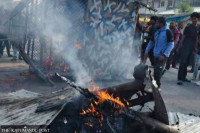National
Disaster response plan on the anvil
In view of rain-related disasters that kill hundreds of people and displace families in large numbers, the government has come up with the Monsoon Emergency Work-plan 2018.
In view of rain-related disasters that kill hundreds of people and displace families in large numbers, the government has come up with the Monsoon Emergency Work-plan 2018.
Following the devastating floods in the plains last year, the government seems to be more concerned about early preparedness for rain-induced disasters.
National Emergency Operation Centre (NEOC) chief Shankar Hari Acharya said the government has started works for minimising the loss lives and property.
The work plan outlines the roles and responsibilities of various governmental and non-governmental agencies during and after a disaster, said Acharya.
Roles have been assigned to stakeholders such as security forces, and local and provincial agencies and other actors involved in rescue and rehabilitation missions, he added.
The government has also directed the District Coordination Committees to draft preparedness plans. The early warning system would be strengthened while the Department of Hydrology and Meteorology circulates disaster forecasts to the district agencies.
The department would monitor water level in major and medium-sized rivers across the country. Information on water flow in the rivers and rising water level would be disseminated to the DDC and the NEOC, which warn local communities through FM stations.
The plan also stresses the need to identify settlements prone to landslide and inundation for warning vulnerable communities through local media beforehand.
Security forces would also be preparing plans for mobilisation with necessary tools for rescue and search operations.
Early warning system would be made more effective through a localised SMS system through which the government provides regular weather updates on mobile phones and warning for potential disasters.
Last year, SMSes helped people move to safer places whenever water level went up in nearby rivers. According to officials, more than 10 million and 4 million SMSes were sent through NT and Ncell networks, respectively, last year.
Security forces, the Department of Roads, District Coordination Committees and local governments are directed to keep heavy equipment ready at designated places while the NEOC and District Emergency Operation Centre are alerted for possible catastrophes.
According to Madhusudan Gautam, a disaster and resilience expert, strengthening capacity of local federal units and their mobilisation can be crucial in dealing with incidents of disaster. The local units should immediately form the Local Disaster Management Committee and take steps for minimising the loss of lives and property, he said.
The government also maintains stocks of relief materials. The Humanitarian Country Team comprising governmental and non-governmental agencies will prepare and implement a strategy for storing relief materials.
Last year, more than 150 people died and property worth billions of rupees was destroyed when floods wreaked havoc in the Tarai districts.




 9.12°C Kathmandu
9.12°C Kathmandu












%20(1).jpg&w=300&height=200)

